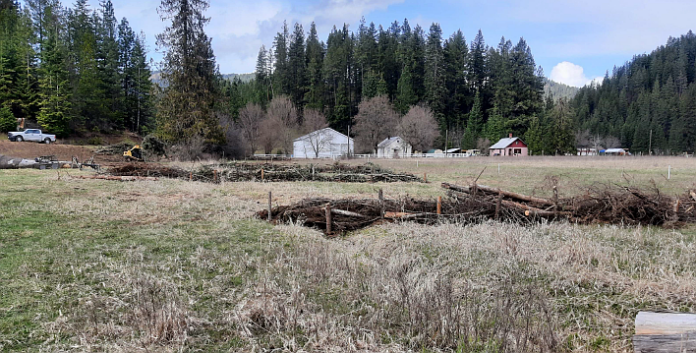CATALDO — The Clearwater Soil and Water Conservation District and the Kootenai-Shoshone SWCD recently completed conservation projects intended to slow down spring runoff, reduce sediment flows and enhance fish habitat.
The projects were completed using primitive woody structures called Beaver Dam Analogs and Post-Assisted Log Structures.
The Kootenai-Shoshone District project led to the installation of multiple PALS structures on 1,100 feet of Schlagel Slough as it flows through a pasture on a cattle and horse ranch owned by Albert Walsh in Cataldo.
“I’m very happy with it so far,” Walsh said. “We’re trying to get as much water in the soil profile as possible and re-create the riparian habitat that had been turned into, essentially, a gutter.”
“It’s nice to work with a conservation-minded landowner,” said Jenna Ditzel, natural resource conservationist for the Conservation Commission, based in Coeur d’Alene.
Bill Lillibridge, project engineer for the Idaho Soil and Water Conservation Commission, designed the project. Funding for the project came from a Leading Idaho grant from the Idaho Department of Environmental Quality/Environmental Protection Agency.
“We’re trying to hold more water uphill on our landscape,” Walsh said. “We can’t control how much rain or snow falls on our ranch, but we can control how fast it runs off.”
Walsh is working with the Kootenai-Shoshone District to convert a hayfield adjacent to Schlagel Slough back to a wetland, while retaining some grazing value for his cattle and horses. The project is located on the lower end of Schlagel Draw, which flows into the Cataldo Slough.
Schlagel Slough is a narrow waterway, approximately 2 feet wide and 1 foot deep at maximum flow, said Karla Freeman, Kootenai District administrator, who landed the Leading Idaho grant for the project. Final design called for installing nine PALS structures and six brush plugs to slow down water flow during spring runoff and encourage water-spreading across the floodplain.
Overall, 1,100 feet of floodplain PALS were installed to demonstrate their usefulness in reducing sediment loads and re-hydrating floodplains. About 370 willows were planted in the floodplain as well to improve habitat, provide shade and catch additional sediment.
During the project installation this year, there were some surprises — water seeped into the ground much faster than expected.
But Walsh is fine with water seeping into the ground.
“The soil will act like a sponge and eventually, we’ll build up the water table and store more water on our farm before it runs off into the Coeur d’Alene River,” he said.




